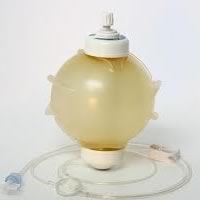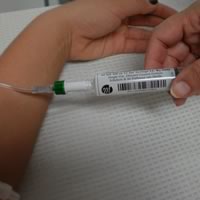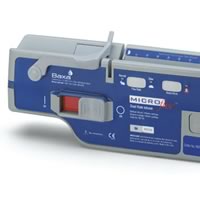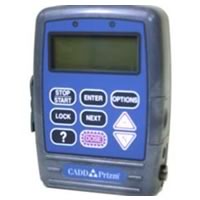There are a variety of infusion methods your healthcare provider may order for you to receive your IV medication. Often your infusion method is dictated by the type of medication you are receiving, but some medications are able to be infused in different ways, and we will accommodate your personal preference and healthcare provider’s orders.
 Elastomeric Pump – Also called a “Home Ball” or “Ball Pump” this device is prefilled with your medication and can connect directly to the needleless connector on your extension set. Opening the clamp on the tubing releases the medication at a prescribed rate. It is portable and can be put in a loose pocket or bag while infusing allowing the patient to be completely mobile. When the infusion is finished the entire device is then discarded. This is considered, by most, to be an easy and convenient method in which to receive your medication.
Elastomeric Pump – Also called a “Home Ball” or “Ball Pump” this device is prefilled with your medication and can connect directly to the needleless connector on your extension set. Opening the clamp on the tubing releases the medication at a prescribed rate. It is portable and can be put in a loose pocket or bag while infusing allowing the patient to be completely mobile. When the infusion is finished the entire device is then discarded. This is considered, by most, to be an easy and convenient method in which to receive your medication.- NEW Elastomeric PUMP ……. SMARTeZ Elastomeric PUMP – Here are a few items that are important regarding this NEW pump that will help you become more familiar and improve your knowledge of this new product. First, the Time to Room Temperature from both freezing and refrigerated temperatures are a little different. Here are the stats for the three most used sizes:
-
SMARTeZ PUMP 100ml @100/hr 250ml @175/hr 400ml@100ml/hr Hours to RT from Frozen 12 18 18 Hours to RT from Refrigerated 6 12 12 - SMARTeZ PUMP: The temperature of the Flow Restrictor on the pump has an effect on infusion time. The Flow Restrictor should be close to or in contact with the skin (ave temperature 31 degrees Celsius) an increase in 1 degree Celsius increases the flow by 2.5%, conversely a decrease in 1 degree Celsius will decrease the flow by 2.5%. Also, if Dextrose 5% is used as a diluent the rate of infusion decreases by 10%
 Gravity IV – Medication is in an IV bag, and the bag is spiked with tubing. The infusion then drips by gravity, controlled by the roller clamp or by a Dial-a-Flo device on the tubing. It is necessary for the bag to hang higher than the IV line, most often on an IV pole or an arrangement in the home such as a hook, for this to be an effective infusion method. The patient is connected to the IV administration tubing throughout the duration of their infusion therefore restricting mobility.
Gravity IV – Medication is in an IV bag, and the bag is spiked with tubing. The infusion then drips by gravity, controlled by the roller clamp or by a Dial-a-Flo device on the tubing. It is necessary for the bag to hang higher than the IV line, most often on an IV pole or an arrangement in the home such as a hook, for this to be an effective infusion method. The patient is connected to the IV administration tubing throughout the duration of their infusion therefore restricting mobility.
 IV Push – When appropriate, some medications may be infused from a syringe directly into a patient’s IV line. This method should be used only for medications that do not require infusion over a period of time since an IV Push is administered relatively quickly. A patient would not require additional tubing for this method of infusion since the syringe connects directly to the needleless connector on the extension set. Certain medications may cause adverse effects if administered too quickly, so this approach must be used with extreme caution.
IV Push – When appropriate, some medications may be infused from a syringe directly into a patient’s IV line. This method should be used only for medications that do not require infusion over a period of time since an IV Push is administered relatively quickly. A patient would not require additional tubing for this method of infusion since the syringe connects directly to the needleless connector on the extension set. Certain medications may cause adverse effects if administered too quickly, so this approach must be used with extreme caution.
 Syringe Pump – This is a method to receive an IV Push medication in a more controlled manner. The syringe is loaded into the pump and the pump pushes the plunger at a prescribed rate. The syringe connects to your extension set in the same way as an IV push without the pump.
Syringe Pump – This is a method to receive an IV Push medication in a more controlled manner. The syringe is loaded into the pump and the pump pushes the plunger at a prescribed rate. The syringe connects to your extension set in the same way as an IV push without the pump.
 Mechanical Pump – A Mechanical Pump is considered to be the most controlled method for IV infusions as it is programmable and able to provide a patient with the required infusion rate needed for their medication. This type of device requires special tubing.
Mechanical Pump – A Mechanical Pump is considered to be the most controlled method for IV infusions as it is programmable and able to provide a patient with the required infusion rate needed for their medication. This type of device requires special tubing.
